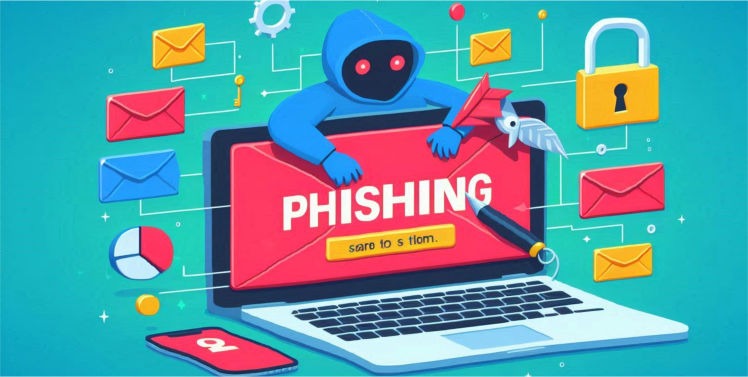Sextortion Phishing Attack Email Scam
In recent months, sextortion phishing attack emails have surged, using personal information to extort money from victims. Learn how cybercriminals spoof email addresses and create fear to manipulate people. Stay informed to protect yourself from these sextortion scams.
PHISHING ATTACK
4/17/20253 min read
Sextortion Phishing Attack Email Scam
In recent months, there's been a notable increase in Phishing emails claiming, "I sent you an email from your email account." An email claiming, "I sent you this email from your own account," is typically a scam or Phishing_Attack Email. This alarming trend, often categorized as sextortion using Phishing Attack Email Scam, targets individuals by creating a false sense of urgency and fear. The perpetrators typically leverage personal information to coerce victims into complying with their demands. Cybercriminals spoof your email address to trick you into believing they've hacked your account. These phishing attack emails may claim to have compromising information or demand payment in exchange for silence. They exploit fear to prompt immediate action. However, seeing your address as the sender doesn't necessarily mean your account has been hacked. It’s likely spoofed, a technique where they forge email headers.
How Sextortion Phishing Attack Email Scam is Done
Sextortion phishing attack emails exploit fear and embarrassment to manipulate victims. Cybercriminals use email spoofing to make it appear as though the message was sent from the recipient's own account. These phishing attack emails will claim that the sender has hacked the victim's device, accessed their webcam, and recorded compromising footage. They may also allege possession of sensitive personal information of the victim with them. The phishing message typically demands payment, often in cryptocurrency, to prevent the release of this supposed material to contacts or to the the public.
In reality, these claims are usually false, and the sender has not hacked the victim's account or device. The email address is spoofed, a technique that forges the sender's identity. If you have fallen victim to such Sextortion Phishing Attack Email scam, you are advised not to respond, avoid clicking on any links, and report the email as spam. Strengthening account security with strong passwords and enabling two-factor authentication can help prevent such phishing Attack. In addition you may use an industry standard Anti-Malware software like Malwarebytes to scan your device to detect and remove any Malware that the cybercriminal may have installed in your device before they can do any harm based on behavioral analysis.
Recognizing Sextortion Phishing Email Scam
Recognizing a sextortion email scam or phishing attack involves spotting key red flags. These emails often claim to have hacked your device, accessed your webcam, or obtained compromising information about you. They may demand payment, usually in cryptocurrency, to prevent the release of this supposed material. Look for signs like poor grammar, generic greetings, or suspicious email addresses. The sender might spoof your email address to make it appear as though the message came from your own account. Avoid clicking on links or attachments, and never respond to such emails.
How to Protect Yourself from Phishing Email Scam
Awareness is your first line of defense against sextortion scam emails leading to phishing attacks. Firstly, never open attachments or click links in suspicious phishing attack email as you might end up installing Malware on your device. If the email makes threats, do not panic, because scammers often rely on fear tactics to compel victims into payment. Instead, report the email to your local authorities and the email service provider. Furthermore, enhance your digital security by employing strong, unique passwords and considering two-factor authentication. Being vigilant about your online presence can significantly reduce your risk of becoming a target. Protecting yourself from sextortion scam emails and phishing attack scams requires vigilance and proactive measures:
Strong Passwords: Use unique and complex passwords for your accounts. Avoid reusing passwords across platforms.
Two-Factor Authentication (2FA): Enable 2FA for an added security layer always.
Beware of Red Flags: Watch for generic greetings, grammatical errors, or threatening language in emails.
Don’t Click Suspicious Links: Avoid clicking on links or attachments in unsolicited emails.
Email Verification: Check sender addresses carefully for authenticity.
Secure Devices: Keep your operating system, antivirus, anti-malware and other software updated.
Avoid Interaction: Do not reply or engage with scammers.
Report and Block: Mark such emails as spam and report them to relevant authorities.
Anti-Malware Software: Install Malwarebytes in all your devices to protect from all Viruses, Malware, Trojan Horse, Ransomware, Spyware, Worms etc.
Understanding sextortion email and phishing attack is crucial in today’s digital environment. By recognizing the signs of phishing attack scam and knowing how to respond to a phishing attack email, you can defend yourself effectively. As the sophistication of these scams continues to evolve, remaining informed and proactive is essential. If you ever find yourself on the receiving end of such phishing attack scams, remember: you are not alone, and there are steps you can take to secure your information. Being cautious and informed is your best defense!
Watch this Video that explains Sextortion Phishing attack Emails and how to protect yourself from these scams.

Cyber Security Threats
Malwarebytes Premium
Protect all your devices from all Malware and Viruses
© 2025. All rights reserved.


